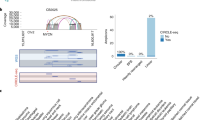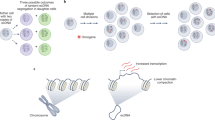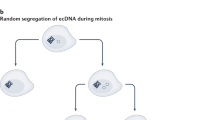Abstract
CoAA is an RRM-containing transcriptional coactivator that stimulates transcriptional activation and regulates alternative splicing. We show that the CoAA gene is amplified at the chromosome 11q13 locus in a subset of primary human cancers including non-small cell lung carcinoma, squamous cell skin carcinoma and lymphoma. Analysis of 42 primary tumors suggests that CoAA amplifies independently from the CCND1 locus. Detailed mapping of three CoAA amplicons reveals that the amplified CoAA gene is consistently located at the 5′ boundaries of the amplicons. The CoAA coding and basal promoter sequences are retained within the amplicons but upstream silencing sequences are lost. CoAA protein is overexpressed in tumors containing the amplified CoAA gene. RNA dot blot analysis of 100 cases of primary tumors suggests elevated CoAA mRNA expression. CoAA positively regulates its own basal promoter in transfection assays. Thus, gene amplification, loss of silencing sequence and positive feedback regulation may lead to drastic upregulation of CoAA protein. CoAA has transforming activities when tested in soft agar assays, and CoAA is homologous to oncoproteins EWS and TLS, which regulate alternative splicing. These data imply that CoAA may share a similar oncogenic mechanism with oncogene EWS and that CoAA deregulation may alter the alternative splicing of target genes.
This is a preview of subscription content, access via your institution
Access options
Subscribe to this journal
Receive 50 print issues and online access
$259.00 per year
only $5.18 per issue
Buy this article
- Purchase on Springer Link
- Instant access to full article PDF
Prices may be subject to local taxes which are calculated during checkout








Similar content being viewed by others
References
Antonson P, Schuster GU, Wang L, Rozell B, Holter E, Flodby P et al. (2003). Inactivation of the nuclear receptor coactivator RAP250 in mice results in placental vascular dysfunction. Mol Cell Biol 23: 1260–1268.
Anzick SL, Kononen J, Walker RL, Azorsa DO, Tanner MM, Guan XY et al. (1997). AIB1, a steroid receptor coactivator amplified in breast and ovarian cancer. Science 277: 965–968.
Aranda A, Pascual A . (2001). Nuclear hormone receptors and gene expression. Physiol Rev 81: 1269–1304.
Auboeuf D, Dowhan DH, Dutertre M, Martin N, Berget SM, O'Malley BW . (2005). A subset of nuclear receptor coregulators act as coupling proteins during synthesis and maturation of RNA transcripts. Mol Cell Biol 25: 5307–5316.
Auboeuf D, Dowhan DH, Li X, Larkin K, Ko L, Berget SM et al. (2004). CoAA, a nuclear receptor coactivator protein at the interface of transcriptional coactivation and RNA splicing. Mol Cell Biol 24: 442–453.
Auboeuf D, Honig A, Berget SM, O'Malley BW . (2002). Coordinate regulation of transcription and splicing by steroid receptor coregulators. Science 298: 416–419.
Brett D, Whitehouse S, Antonson P, Shipley J, Cooper C, Goodwin G . (1997). The SYT protein involved in the t(X;18) synovial sarcoma translocation is a transcriptional activator localised in nuclear bodies. Hum Mol Genet 6: 1559–1564.
Buttel I, Fechter A, Schwab M . (2004). Common fragile sites and cancer: targeted cloning by insertional mutagenesis. Ann NY Acad Sci 1028: 14–27.
Bystritskiy AA, Razin SV . (2004). Breakpoint clusters: reason or consequence? Crit Rev Eukaryot Gene Expr 14: 65–77.
Caiafa P, Zampieri M . (2005). DNA methylation and chromatin structure: the puzzling CpG islands. J Cell Biochem 94: 257–265.
Clark J, Rocques PJ, Crew AJ, Gill S, Shipley J, Chan AM et al. (1994). Identification of novel genes, SYT and SSX, involved in the t(X;18)(p11.2;q11.2) translocation found in human synovial sarcoma. Nat Genet 7: 502–508.
Coquelle A, Pipiras E, Toledo F, Buttin G, Debatisse M . (1997). Expression of fragile sites triggers intrachromosomal mammalian gene amplification and sets boundaries to early amplicons. Cell 89: 215–225.
Das PM, Singal R . (2004). DNA methylation and cancer. J Clin Oncol 22: 4632–4642.
Fox AH, Lam YW, Leung AK, Lyon CE, Andersen J, Mann M et al. (2002). Paraspeckles: a novel nuclear domain. Curr Biol 12: 13–25.
Gibbons R, Dugaiczyk A . (2005). Phylogenetic roots of Alu-mediated rearrangements leading to cancer. Genome 48: 160–167.
Grandinetti KB, Spengler BA, Biedler JL, Ross RA . (2006). Loss of one HuD allele on chromosome #1p selects for amplification of the N-myc proto-oncogene in human neuroblastoma cells. Oncogene 25: 706–712.
Greaves MF, Wiemels J . (2003). Origins of chromosome translocations in childhood leukaemia. Nat Rev Cancer 3: 639–649.
Guan XY, Xu J, Anzick SL, Zhang H, Trent JM, Meltzer PS . (1996). Hybrid selection of transcribed sequences from microdissected DNA: isolation of genes within amplified region at 20q11-q13.2 in breast cancer. Cancer Res 56: 3446–3450.
Iwasaki T, Chin WW, Ko L . (2001). Identification and characterization of RRM-containing coactivator activator (CoAA) as TRBP-interacting protein, and its splice variant as a coactivator modulator (CoAM). J Biol Chem 276: 33375–33383.
Jasinska A, Krzyzosiak WJ . (2004). Repetitive sequences that shape the human transcriptome. FEBS Lett 567: 136–141.
Kalnina Z, Zayakin P, Silina K, Line A . (2005). Alterations of pre-mRNA splicing in cancer. Genes Chromosomes Cancer 42: 342–357.
Kim CF, Jackson EL, Woolfenden AE, Lawrence S, Babar I, Vogel S et al. (2005). Identification of bronchioalveolar stem cells in normal lung and lung cancer. Cell 121: 823–835.
Kim J, Pelletier J . (1999). Molecular genetics of chromosome translocations involving EWS and related family members. Physiol Genom. 1: 127–138.
Ko L, Cardona GR, Chin WW . (2000). Thyroid hormone receptor-binding protein, an LXXLL motif-containing protein, functions as a general coactivator. Proc Natl Acad Sci USA 97: 6212–6217.
Koreth J, Bakkenist CJ, McGee JO . (1999). Chromosomes, 11Q and cancer: a review. J Pathol 187: 28–38.
Kuang SQ, Liao L, Zhang H, Pereira FA, Yuan Y, DeMayo FJ et al. (2002). Deletion of the cancer-amplified coactivator AIB3 results in defective placentation and embryonic lethality. J Biol Chem 277: 45356–45360.
Lammie GA, Peters G . (1991). Chromosome 11q13 abnormalities in human cancer. Cancer Cells 3: 413–420.
Lee J, Rhee BK, Bae GY, Han YM, Kim J . (2005). Stimulation of Oct-4 activity by Ewing's sarcoma protein. Stem Cells 23: 738–751.
McKenna NJ, O'Malley BW . (2002). Combinatorial control of gene expression by nuclear receptors and coregulators. Cell 108: 465–474.
Penalva LO, Sanchez L . (2003). RNA binding protein sex-lethal (Sxl) and control of Drosophila sex determination and dosage compensation. Microbiol Mol Biol Rev 67: 343–359, table of contents.
Rabbitts TH . (1994). Chromosomal translocations in human cancer. Nature 372: 143–149.
Rabbitts TH . (1999). Perspective: chromosomal translocations can affect genes controlling gene expression and differentiation – why are these functions targeted? J Pathol 187: 39–42.
Schmid CW . (1998). Does SINE evolution preclude Alu function? Nucleic Acids Res 26: 4541–4550.
Smith CW, Patton JG, Nadal-Ginard B . (1989). Alternative splicing in the control of gene expression. Annu Rev Genet 23: 527–577.
Sorensen PH, Triche TJ . (1996). Gene fusions encoding chimaeric transcription factors in solid tumours. Semin Cancer Biol 7: 3–14.
Torres-Arzayus MI, Font de Mora J, Yuan J, Vazquez F, Bronson R, Rue M et al. (2004). High tumor incidence and activation of the PI3K/AKT pathway in transgenic mice define AIB1 as an oncogene. Cancer Cell 6: 263–274.
Yang L, Chansky HA, Hickstein DD . (2000). EWS.Fli-1 fusion protein interacts with hyperphosphorylated RNA polymerase II and interferes with serine-arginine protein-mediated RNA splicing. J Biol Chem 275: 37612–37618.
Yang XJ . (2004). The diverse superfamily of lysine acetyltransferases and their roles in leukemia and other diseases. Nucleic Acids Res 32: 959–976.
Zainabadi K, Benyamini P, Chakrabarti R, Veena MS, Chandrasekharappa SC, Gatti RA et al. (2005). A 700-kb physical and transcription map of the cervical cancer tumor suppressor gene locus on chromosome 11q13. Genomics 85: 704–714.
Zinszner H, Albalat R, Ron D . (1994). A novel effector domain from the RNA-binding protein TLS or EWS is required for oncogenic transformation by CHOP. Genes Dev 8: 2513–2526.
Acknowledgements
This work was supported, in part, by the Georgia Cancer Coalition (L Ko). We thank Paul S Meltzer at National Institutes of Health for discussion of the manuscript. We thank Liu Yang at University of Washington for the EWS-Fli plasmids, and Ning Zhu at MCLab for synthesis of the AxxQ mutant. We thank Rhea Markowitz and Diana G Westbrook for manuscript editing. We are grateful for the help of Mei H Lai at Eli Lilly and Company, and Fermina Mazzella, Jin-Xiong She, Zixuan Wang, Kimberly Smith, and Doris Cawley at Medical College of Georgia. Zheqiong Yang is an exchange trainee from Wuhan University, China.
Author information
Authors and Affiliations
Corresponding author
Additional information
Supplementary Information accompanies the paper on the Oncogene website (http://www.nature.com/onc).
Supplementary information
Rights and permissions
About this article
Cite this article
Sui, Y., Yang, Z., Xiong, S. et al. Gene amplification and associated loss of 5′ regulatory sequences of CoAA in human cancers. Oncogene 26, 822–835 (2007). https://doi.org/10.1038/sj.onc.1209847
Received:
Revised:
Accepted:
Published:
Issue Date:
DOI: https://doi.org/10.1038/sj.onc.1209847
Keywords
This article is cited by
-
RBM14 as a novel epigenetic-activated tumor oncogene is implicated in the reprogramming of glycolysis in lung cancer
World Journal of Surgical Oncology (2023)
-
The growth hormone receptor interacts with transcriptional regulator HMGN1 upon GH-induced nuclear translocation
Journal of Cell Communication and Signaling (2023)
-
RNA processing as an alternative route to attack glioblastoma
Human Genetics (2017)
-
The tumor suppressor annexin A10 is a novel component of nuclear paraspeckles
Cellular and Molecular Life Sciences (2014)
-
Isolation and identification of a distinct side population cancer cells in the human epidermal squamous cancer cell line A431
Archives of Dermatological Research (2011)



